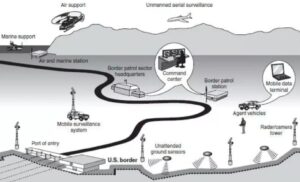Technical solutions are necessary to augment and complement the traditional methods of border guarding. They not only enhance the surveillance and detection capabilities of the border guarding forces but also improve the impact of the border guarding personnel against infiltration and trans-border crimes.
- What is a Smart Wall?
- Advantages of Small Wall
- Hurdles for implementation in India
Content:
United States President Joe Biden has halted the construction of the much-publicised ‘border wall’ between the United States and Mexico.
However, an alternative ‘Smart wall’ has been proposed to replace the physical and armed patrolling with advanced surveillance technology.
What is a Small Wall?
- At present, there’s no single definition for the ‘Smart Wall’.
- A smart wall will use technologies such as scanners, sensors and radars to prevent illicit entry, smuggling and other border threats.
- The smart wall will empower border officials and enhance situational awareness to prevent illicit activities.
- It will incorporate Internet-of-Things (IoT) technologies (such as sensors, security cameras, software solutions) to distinguish between animals, humans and vehicles.
- An alert will be sent to the officers in case of border breaches by humans.
- Such a wall will create a technological barrier.

Advantages of Small Wall:
In general, Smart Wall has the following benefits:
- Cost Friendly: A Smart Wall can accomplish the same goals as a physical wall but at a much lower price.
- Quick Deployment: Physical wall will take years to be developed while the Smart Wall is ready to go technology.
- Customisation: A Smart Wall will allow border security officials to adjust tactics as per the situations.
- Ease of Upgradation: IoT devices are quick and easy to deploy and are inexpensive to move and update.
- Low Maintenance: The maintenance cost of a Smart Wall is much less than a physical wall.
- Environment Friendly: Smart Wall raises minimal environmental concerns, allowing wildlife and rainwater to pass freely through the area.
- Easy Surveillance of rugged terrain: Rough terrains are difficult to patrol, making the border vulnerable to breaches. Smart Wall will overcome this drawback posed by a physical wall, enhancing the surveillance across a vast terrain.
- Limited Land Use: Smart Wall technology requires fewer land acquisition by the government as compared to a physical border.
- Quick Response to threats: IoT technologies will allow patrolling agents to survey hundreds of miles at a time. Additionally, a real-time alert will make it easy for them to respond to activity from immigrants approaching the border or to a lost hiker looking for supplies.
In the Indian Border Security context:
- Smart Wall will enhance critical security establishments across long boundaries of India and complement existing fencing and walls.
- If deployed along the Indian borders, will provide the security forces present at the border with an advantage over enemies and border infiltration can be effectively countered.
- The problem of cross-border terrorism and smuggling in India could be reduced effectively.
Smart Fencing in India
- In India, two pilot projects have been completed with state-of-the-art surveillance technologies at Indo-Pakistan Border (10 Kms) and Indo-Bangladesh Border (61 Kms).
- These projects are termed as Comprehensive Integrated Border Management System (CIBMS)
- CIBMS uses smart surveillance devices and analyses data in real-time.
- It involved the deployment of thermal imagers, infra-red and laser-based intruder alarms, aerostats for aerial surveillance, unattended ground sensors to detect intrusion bids, radars, sonar systems to secure riverine borders, fibre-optic sensors and a command and control system.
- Border Electronically Dominated QRT Interception Technique (BOLD-QIT) under CIBMS is used on the Indo-Bangladesh border in Assam’s Dhubri district.
Hurdles for implementation in India:
- The BSF does not have the required technical expertise to offer clear guidelines to the vendors so that they can provide suitable products.
- In the case of India, it is widely accepted that the operation and maintenance of the existing sophisticated equipment remain a problem.
- At present, many of the high-tech surveillance devices deployed by the BSF are not optimally utilised because the required technical expertise is not uniformly available among the force’s personnel.
- Furthermore, the exorbitant cost of the electronic devices and the lack of easy availability of spare parts act as a deterrent against their use
- Erratic power supply and adverse climatic and terrain conditions in the border areas could potentially undermine the functioning of the sophisticated system
Issues in Electronic Border Management in India
An in-depth assessment of the existing electronic surveillance systems in border management revealed that it suffered from a number of shortcomings which hampered effective functioning.
Some of the shortcomings highlighted were:
- the high-tech equipment being used did not provide all-round security and did not work in adverse climatic conditions;
- significant gaps remained at rivers and nullahs running along the fences;
- being manpower intensive, the system was not effective in providing rest and relief to BSF troops; and,
- it is not an integrated system and therefore failed to provide a common operating picture at all levels.
Given these shortcomings, the Border Security Force (BSF) argued that a new, efficient and high-tech surveillance system for border guarding is urgently required to prevent infiltration by terrorists and smugglers.
- Introduction
- Briefly define Smart Wall
- Highlight India’s Border Security Issues
- Write the advantages of Smart Wall in solving these problems
- Discuss the challenges for implementing such projects
- Conclusion
















